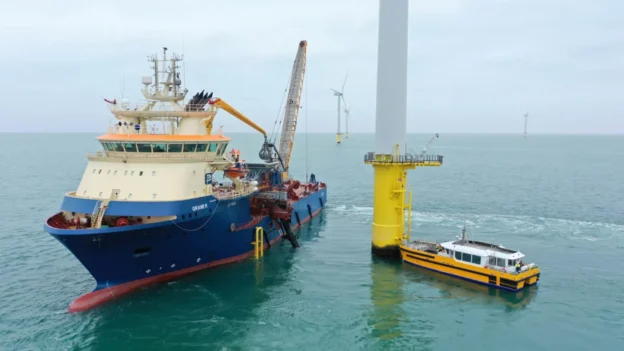In the United Kingdom, the energy company RWE and the firm specializing in nature-inclusive technologies ARC Marine have initiated a new phase in the sustainable development of marine infrastructure. This is the first large-scale deployment of Reef Cubes as an erosion protection system at an operating wind farm.
Critical infrastructure with positive impact on biodiversity
Over the past few days, contractor Rohde Nielsen has completed the installation of approximately 75,000 Reef Cubes around a turbine at the Rampion offshore wind farm. These 15 to 35 cm modular blocks are designed to protect the turbine foundations from strong currents, but also to create new colonization spaces for marine species.
With a total surface area of 25,000 square meters of potential habitat, the structure of the Reef Cubes structure facilitates the proliferation of fish, mollusks and other life forms. Its patented design allows for twice the habitat volume of conventional rock shelters and up to 38% more available surface area.
Reef Cubes as a modular alternative for underwater protection
Unlike traditional solutions, Reef Cubes are modular, lighter and easier to install. They are made of local materials, are recyclable and compatible with the biodiversity net gain targets required by the new environmental regulations for energy projects.
Thomas Michel, COO of RWE Offshore Wind, noted that this collaboration represents a significant breakthrough in combining technical efficiency with ecological benefit. Tom Birbeck, CEO of ARC Marine, noted the global potential of this technology to transform the way subsea infrastructure is protected.
Scientific evaluation and long-term projection
The project, part of the Reef Enhancement for Scour Protection (RESP) program, will now enter an intensive monitoring phase. Between 2026 and 2030, ecological and geophysical studies will be carried out to evaluate the effectiveness of the blocks as a defense against erosion and their impact on marine ecosystems.
The initiative confirms RWE’s commitment to a model of offshore wind development that is not only efficient, but also environmentally friendly. In the meantime, the results obtained may guide future implementations in other offshore wind farms around the world.
Source and photo: RWE

